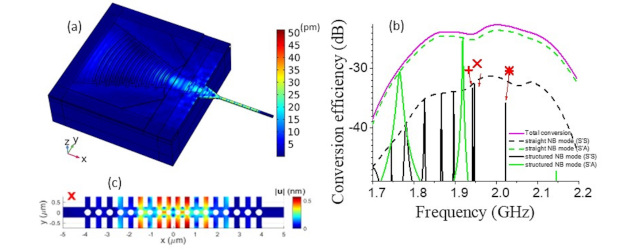Accueil
CHEP2018 Conference Proceedings (Vol. 51, No. 1)

The 23rd International Conference on Computing in High Energy and Nuclear Physics was held in the National Palace of Culture, Sofia, Bulgaria from 9th to 13th of July 2018. The program consisted of 27 plenary, 323 parallel presentations and 188 posters. The plenary talks covered topics such as HPC and cloud computing, machine learning in High Energy Physics (HEP), overviews of experiment software for data acquisition, high level triggering, reconstruction and analysis, experience from astro-particle and neutrino physics, as well as broader subjects like multithreading and vectorization in HEP, use of blockchains, quantum computing, software citation mechanisms. Progress on common and widely used tools and packages in HEP such as ROOT, EOS and CVMFS was also presented. A dedicated talk and a panel discussion were devoted to the implementation of a successful diversity program in the field of HEP and nuclear physics computing.
A. Forti, L. Betev, M. Litmaath, O. Smirnova and P. Hristov (Eds.),, 23rd International Conference on Computing in High Energy and Nuclear Physics (CHEP 2018), Sofia, Bulgaria, July 9-13 , 2018',, EPJ Web of Conferences 214 (2019)
[Proceedings]
NSD2019 Conference Proceedings (Vol. 51, No. 1)

The fourth International Conference on Nuclear Structure and Dynamics NSD2019 was held in Venice on May 13-17, 2019. The conference belongs to a series of conferences devoted to the most recent experimental and theoretical advances in the field of nuclear structure and reactions. The focus was on topics covering most of the research areas in low energy nuclear physics: Nuclear structure and reactions far from stability, Collective phenomena and symmetries, Dynamics and thermodynamics of light and heavy nuclei, Sub and near barrier reactions, Fusion and fission dynamics, Ab-initio calculations, cluster models and shell model, Nuclear energy density functionals, Nuclear astrophysics, Fundamental interactions. Important new results were outlined in the various subfields, spanning the whole range from neutron-deficient to neutron-rich nuclei and from light to heavy ions.
G. de Angelis and L. Corradi (Eds.), IV International Conference on Nuclear Structure and Dynamics (NSD2019), Venice, Italy, May 13-17 , 2019, EPJ Web of Conferences 223 (2019), ISBN: 978-2-7598-9084-2
[Proceedings]
Focusing surface acoustic waves into an optomechanical nanobeam (Vol. 51, No. 1)

Cavity optomechanics (OM) is a topical issue of growing interest due to the potential applications ranging from sensing and communications to quantum information technology. However, the number of phonons created in a cavity by an external optical fibre remains relatively low. An alternative way to induce large phonon population is the use of a phonon pump by transforming an RF signal into surface acoustic waves (SAW). In a simulation work, we demonstrated an efficient focusing and conversion of SAW generated by focusing interdigital transducers (IDT) on piezoelectric aluminum nitride film deposited on silicon on insulator (SOI) into the guided modes of a silicon nanobeam. For a straight nanobeam, we achieve an efficiency of -22dB and displacements about 50pm when applying a voltage of 1V to the IDT. When the nanobeam is structured to form a phononic crystal with a cavity, the guided modes excite some localized modes around 2 GHz inside the cavity with a magnitude of the vibrational motions around 1nm. The preliminary experiments confirm the simulations.
Work is supported by the European Commission through project PHENOMEN, Grant Agreement No. 713450.
Alexander V Korovin et al, Conversion between surface acoustic waves and guided modes of a quasi-periodic structured nanobeam, J. Phys. D: Appl. Phys 52, 32LT01 (2019)
[Abstract]
Multiple magnon modes in a magnetic Weyl semimetal (Vol. 51, No. 1)

An area of interest in condensed matter physics is topological Weyl semimetals (WSMs). There are only a few candidates of magnetically ordered materials for the realisation of WSMs, like the kagome-lattice ferromagnet Co3Sn2S2.
Novel magnon branches are predicted in magnetic Weyl semimetals, which can be understood as a result of the coupling between two magnetic moments mediated by Weyl fermions. Here, we experimentally investigate electron transport in the kagome-lattice ferromagnet Co3Sn2S2, which is regarded as a time-reversal symmetry broken Weyl semimetal candidate. We demonstrate dV/I(I) curves with pronounced asymmetric dV/dI spikes, similar to those attributed to current-induced spin-wave excitations in ferromagnetic multilayers. In contrast to multilayers, we observe several dV /dI spikes’ sequences at low, ≈104 A/cm2 , current densities for a thick single-crystal Co3Sn2S2 flake in the regime of fully spin-polarised bulk. The spikes at low current densities can be attributed to novel magnon branches in magnetic Weyl semimetals, which are predicted due to the coupling between two magnetic moments mediated by Weyl fermions. The presence of spin-transfer effects at low current densities in Co3Sn2S2 makes the material attractive for applications in spintronics.
O. O. Shvetsov et al, Multiple magnon modes in the Co3Sn2S2Weyl semimetal candidate, EPL 127, 57002 (2019)
[Abstract]







